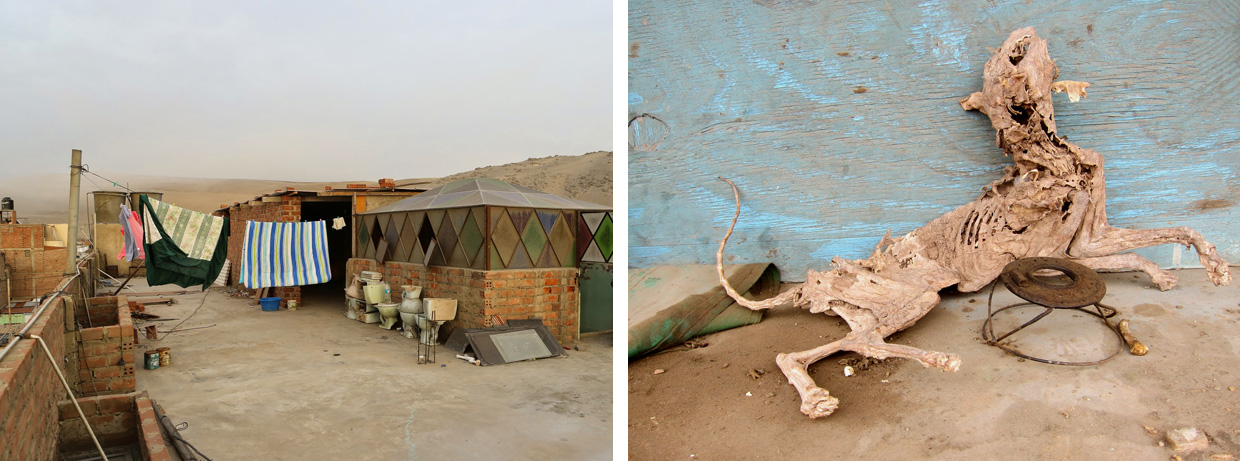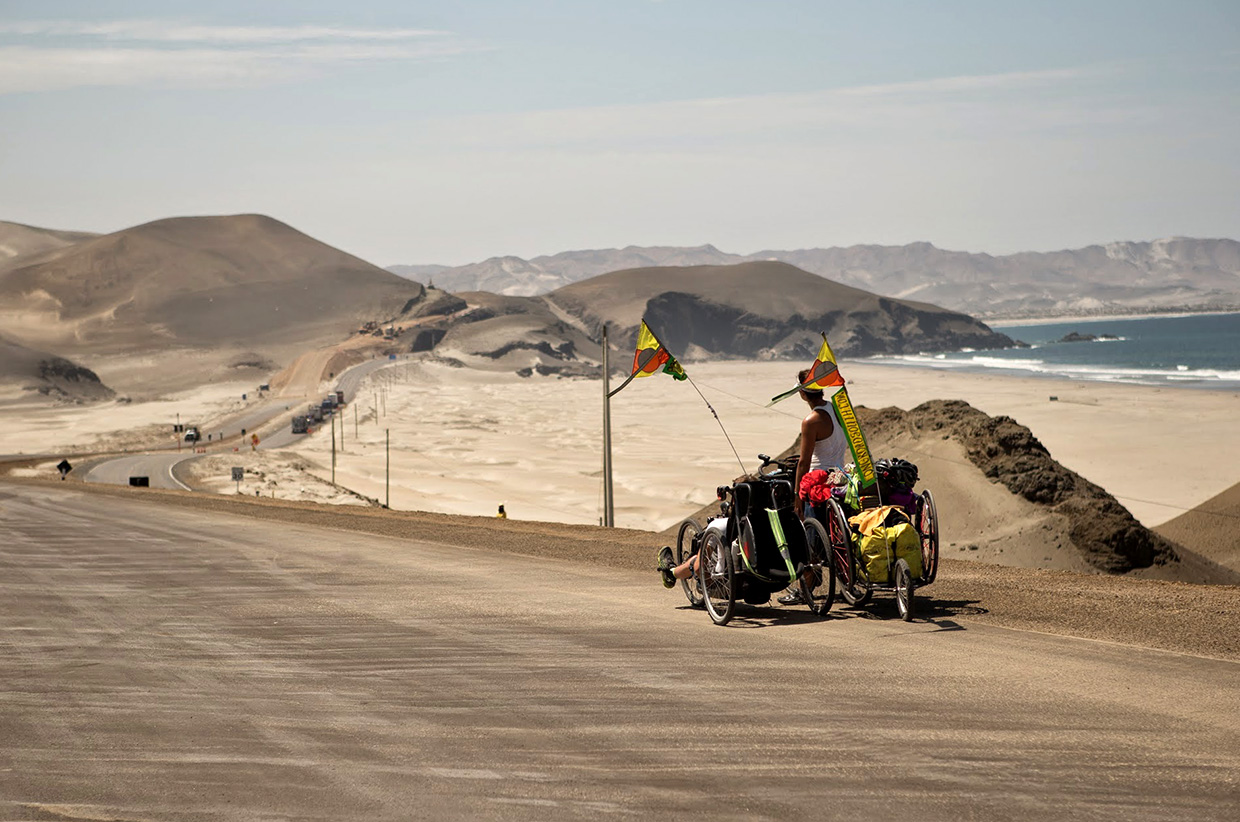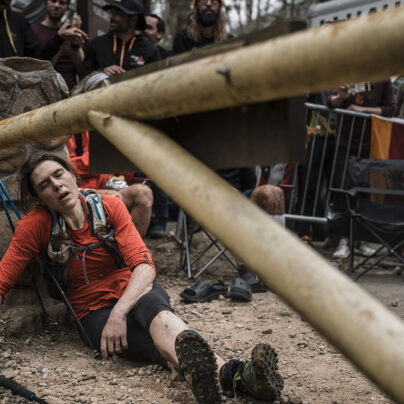The Peruvian Grind
Written by Seth McBride // Photography by Jared Cure
Kelly and Jared are somewhere ahead, perhaps a few hundred yards, possibly more, but they are invisible, shrouded by the storm of sand. Riding a handcycle across the Americas, I am often reminded of my physical limitations, but I suffer alone.
I watch sand flow across the pavement like flood waters. I hear it, abrasive in the wind, now coming from the south southwest, each gust a thousand tiny tacks on my exposed neck. Driven into my mouth, its taste is clean and not particularly unpleasant, but for the grit. I spit to my right, but the glob is driven back by the wind and plastered to my jaw. Forced to keep my lips clamped, there is a complete lack of smell. Out here, where the Peruvian desert runs into the Pacific, it smells as I imagine space might.
Which is to say that there’s not much out here to distract me from the fire in my arms, and the deepening fatigue. Kelly and Jared are somewhere ahead, perhaps a few hundred yards, possibly more, but they are invisible, shrouded by the storm of sand. They can’t move any slower and stay upright. I simply can’t climb any faster. Riding a handcycle across the Americas, I am often reminded of my physical limitations, but I suffer alone. I keep crawling up, always up. How much higher I have no idea, and when I can no longer turn the cranks I stop to rest. 20 or 30 seconds is all I permit myself. We’re not battling light yet, but with the pace we’ve been averaging, and the distance remaining, the math doesn’t look good.
Kelly and I are five months into what’s planned to be a year long, self-supported handcycle/bicycle tour from our home in Portland, Oregon to Patagonia, Argentina. I use a handcycle because I use wheelchair, the result of a skiing accident at the age of 17 that left me with quadriplegia.
We hung the success of the trip on the human body’s ability to adapt. For the first few months, our bodies responded. My upper body got used to the relentless fatigue of 45 to 50 miles each day. Kelly’s legs got used to carrying all of our gear, some 80 kilos worth. But in the sweltering heat of Mexico’s lowlands we crashed into the limits of my compromised themo-regulatory system, and since then our journey has been mired in physiological failures and motorised rescues. So we’d called a friend of mine, Jared, and asked him to help us through one last section of heat. Neither Kelly nor I said it, but if we couldn’t complete that stretch, it was unlikely our journey would continue.
Trujillo is a city of one-million plus, and its outskirts are flat, populated riding that stretched through our first day on the road in Peru. It was short one: 30km to get our muscles loosened back up after a rest and to get Jared used to pedalling a loaded bike.

It wasn’t until our second day that we caught a glimpse of the road to come. The suburb of Miramar, like most of northern coastal Peru, was a patched-together place, a web of crumbling brick and dust. The Pan-American Highway bisected the town as it climbed up to the midpoint of a long sandy ridge that fell away into the ocean. At the edge of town the concrete faded – gone were the bodegas and fereterias and all that remained was sand. Climbing a few hundred more metres, the gradient mellowed and the last vestiges of Trujillo dropped below the horizon behind us. It wasn’t hot, maybe 75 degrees, but the tropical sun had an intensity that bore no relation to the air temperature. It penetrated and flushed immediately. Jared climbed away towards a long road sign creating a narrow line of shade and laid his bike down. We stopped when we reached him. “How are you doing?” Kelly asked.
“Hill’s are fine,” Jared replied, “but this sun is brutal.”
“Have you always hated the heat?” I asked.
“Well, it’s not just hating it,” he responded. “I’m really susceptible to it, I get heatstroke easily.”
I looked at Jared, then past him, to the heat shimmering over an endless expanse of sand. “So maybe you weren’t the best guy to call to help us trek through the desert?”
Jared shrugged.
We continued climbing into the great wide nothing. On the descent, an old bus appeared alongside the road, casting a shadow on the sand. It was only ten am, but at only 9 degrees South, there’s no shade during the day and you need a roof to hide from the sun. We pulled next to the bus, Kelly and Jared slid down to the sand with their backs to it. I sprayed myself with some cool water and pushed the sun, the hills, the riding yet to come, out of my mind. Kelly and I were used to pushing ourselves harder than this, a continual race to get wherever we’re going and maximise our rest at the end of the day, but Jared had little saddle endurance, and really, these were the moments that made the trip. For how many times in your life do a granola bar and the shade of a broken-down bus offer complete contentment?
Later that day we were riding through a collection of roadside buildings that could euphemistically be called a town, when a mongrel dog came flying from behind a stick-built fence to chase Kelly and Jared, before whirling around and charging head on at me. I bellowed as loud as I could, and whipped my front tire at the hound, noticing the frothing at his mouth before as he skittered to the right. He recollected himself immediately and came snarling at my back wheel before a barrage of stones from a local man sent him quivering away. I pedalled on, spiking with adrenalin.
We pulled next to the bus, Kelly and Jared slid down to the sand with their backs to it. I sprayed myself with some cool water and pushed the sun, the hills, the riding yet to come, out of my mind.


We rode single file and couldn’t talk for the road noise. No beautiful scenery, no human interaction, nothing to distract from the unending repetition of pulling ourselves across the desert, one rotation of the cranks at a time.
Kelly and Jared were stopped just ahead. When I reached them Kelly was ready to keep moving, but she saw Jared’s face, flushed and fatigued, when she looked back to me. “Are you okay?” she asked him.
“I need shade.”
Just up the road there was a small store with a leafy tree in front. When we get there Jared leaned his bike against the building wall, bought a big bottle of cold water, and started dumping it on his head. He slumped down against a shaded wall with a vacant look in his eyes. “So fucking hot,” he muttered.
I knew how he felt, and it wasn’t good. When the body passes the threshold of its ability to shed heat, it starts shutting down, overruling the brain’s primary decision-making function. It’s a feeling I know all too well, but it was strange and surreal watching someone else go through it. I was hot, but still functional. I watched Jared lay down on a lumpy patch of concrete, water dripping from his hair and laughed to myself at the absurdity of it – that to this last stretch of heat, we’d summoned the one person I’d seen who has worse thermo-regulation than me, with quadriplegia.
The next morning was cloudy and we climbed from the start. At first it was a grinding annoyance – it looked flat but felt much harder than it should be – then swept up to a higher gradient for the last few miles while the sun came out in full force. After a few stops we topped out and whisked down a fast descent in a cool breeze.
At the bottom there was a collection of buildings even more ramshackle than usual. A faded Coca-Cola sign hung above a door. The only open patch of shade was under a small out building, so I guided my bike there. When Kelly and Jared returned with cold water and cokes, Kelly noticed a companion lying on a ledge of the outbuilding just above my view. A dead cat. And it’d been there a while, legs splayed, fur and skin dried out in natural mummification. It wasn’t hidden, clearly the occupants of this patch of sand had a chance to observe the slow process of decay and decided to leave it where it lay. It stunk a little, but that’s where the shade was, so we sat and cooled off. In front of the main building there were a few stacks of truck tires, covered by scraps of board. One stack held chickens, another ducks. A litter of puppies cried from behind a tarp. A truck packed high with chicken crates pulled off the Pan-American to buy drinks. While the drivers were occupied a mother/daughter team ran out and stole eggs from the holes of a low crate, running off with the loot wrapped in the bottom of their shirts.
For a moment, I shuddered at the thought of daily existence here, the endless, numbing sameness. It’s easy to understand why the great monotheistic religions – Christianity, Islam, Judaism – arose from desert cultures: this can’t be all there is. There must be some divine reality greater than this world of sand and wind.
Presently there was nothing else for us either. When we left, it looked like I was peering through a camera with a grey lens, scouting locations for a post-apocalyptic sci-fi film. We rode single file and couldn’t talk for the road noise. No beautiful scenery, no human interaction, or built environment, nothing to distract from the unending repetition of pulling ourselves across the desert, one rotation of the cranks at a time. But the road cut slightly downhill into this washed out landscape, and Jared caught the urge for speed, passed us and swung in front of Kelly. He chugged into the unrelenting headwind like a diesel engine. Kelly had to find a surge of energy just to stay on his wheel. I sucked in behind her and shifted up, cranking with all the power I’ve built over these long months, feeling the strain flow between my chest, back, and shoulders. The wind brushed tears through my eyes and the terrain smeared into a grey haze. The world was reduced to effort and speed, and that was enough.

The towns – Salaverry, Chao, Chimbote, Barranca, Huacho – cling to the fingers of vegetation that line the rivers flowing from the Andes to the sea. At the end of every day, we reached a sliver of green and it was enough to keep us going. We’d wake early and struggle to get moving before the sun was up and hot. The mornings were often cloudy, but devoid of breeze. In the afternoons the clouds would break and a headwind would rise up, cooling our bodies but slowing our progress. The terrain was cut with one or two larger climbs a day. There was nowhere to camp because the sand was deep to the edge of the highway and our bikes floundered a foot removed from the pavement. There were power lines and occasional shacks constructed of reed. Trips aren’t always exciting thoughout, nor is adventure for that matter, but we’d found our rhythm again. And each day completed gave a renewed sense of confidence, something that had been sorely lacking in South America.
Of course, the desert didn’t let our newfound self-assurance become hubris. Two days later, as we were nearing Lima, there was one last no-man’s-land to traverse – a 45 mile stretch from Huacho to Chancay. The headwind, which usually doesn’t pickup until the afternoon, was blowing with real fury from the outset. It was hot in the morning and our progress was piecemeal and slow. Grinding into the wind, and stopping for shade and water, the hours ticked by and we inched towards our goal. We were all fatigued from the days already done. My stomach had been rebelling for the past week, and as we started up a long climb, I had to swing onto the shoulder of the road and hang my white ass off the side of my bike (squatting isn’t an option when you’re legs don’t work), attempting to hide behind a minuscule road sign as long haul trucks ploughed by.
Then the sandstorm came. Suddenly a long day of cascading annoyances turned into a violent whirlwind – the kind that will tap your deepest passions and make you bellow at the sky. The world closed in around me and it took every synapse, every straining muscle fibre to keep my handcycle moving forward, every stroke a battle – the wind has more energy than I. But I’ve failed enough in the past few months to know exactly what my body reaching its limit feels like, and this is not it. I get mad at the sand and my body responds, I might not be able to go any faster but I can keep grinding on. Eventually this hill will end, the wind will ease off, and all that will be left is whether or not we made it through.



